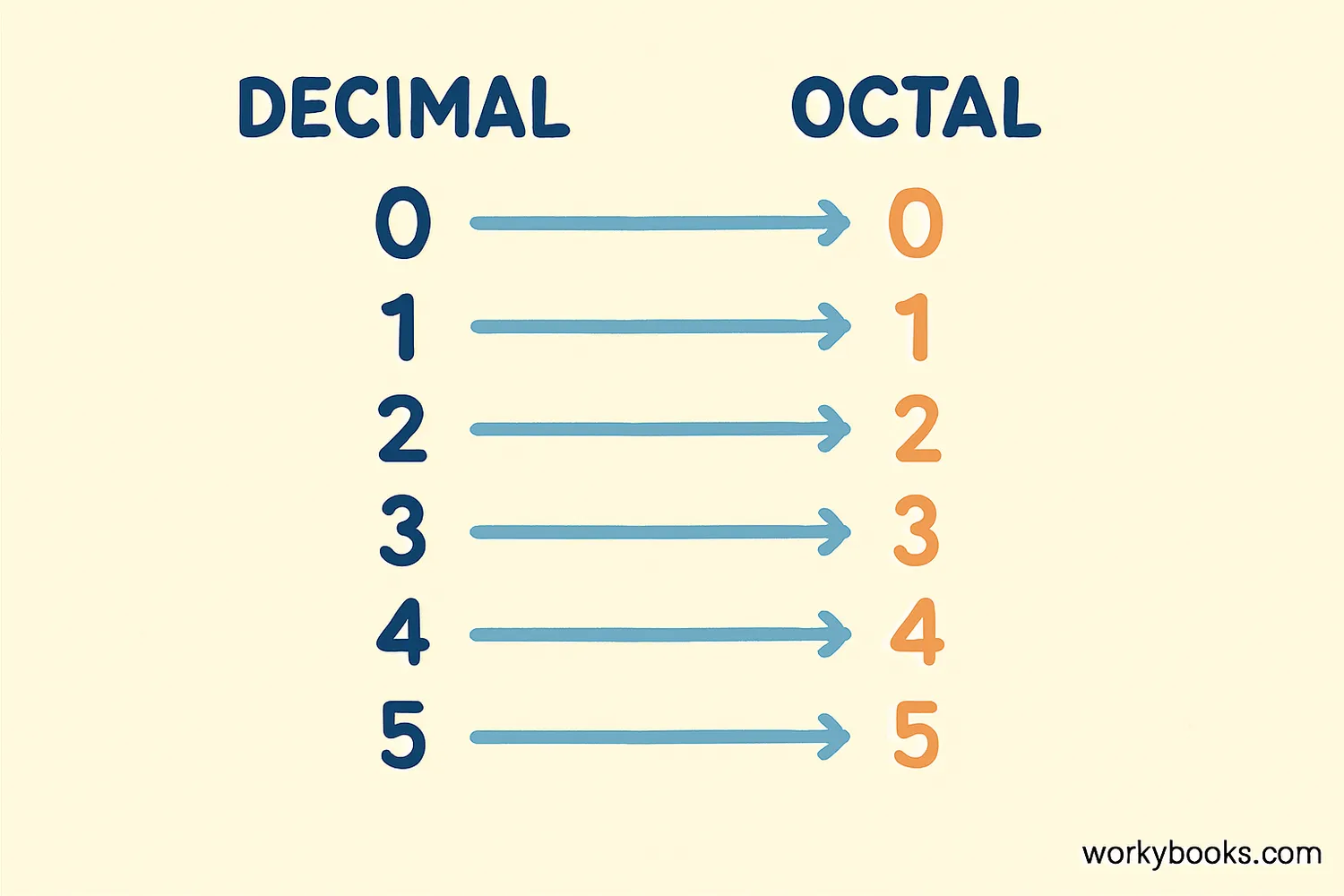Decimal to Octal - Definition, Examples, Quiz, FAQ, Trivia
Learn to convert between decimal and octal number systems with step-by-step methods
Understanding Number Systems

Number systems are different ways to represent numbers. The decimal system (base 10) is what we use every day, with digits 0-9. The octal system (base 8) uses only digits 0-7.
Why learn octal? Computers use binary (base 2) for calculations, but octal provides a shorter way to represent binary numbers. Each octal digit represents three binary digits.
Key differences:
- Decimal: Base 10, digits 0-9
- Octal: Base 8, digits 0-7
- Decimal 8 = Octal 10
- Decimal 16 = Octal 20
Base Systems Explained
The base of a number system tells us how many digits are available. Decimal has 10 digits (0-9), octal has 8 digits (0-7).
How to Convert Decimal to Octal
Converting decimal numbers to octal is done using the division-by-8 method:
Conversion Method
1. Divide the decimal number by 8
2. Write down the remainder
3. Divide the quotient by 8
4. Repeat until quotient is 0
5. Read remainders in reverse order
Important Tip
Remainders will always be between 0 and 7 since we're dividing by 8. These become your octal digits.
Decimal to Octal Conversion Chart
This chart shows common decimal numbers and their octal equivalents. Notice how octal numbers increase faster than decimal numbers because octal has fewer digits.
Decimal to Octal Conversion Table
| Decimal | Octal | Calculation Steps |
|---|---|---|
| 0 | 0 | - |
| 1 | 1 | 1 ÷ 8 = 0 rem 1 |
| 2 | 2 | 2 ÷ 8 = 0 rem 2 |
| 7 | 7 | 7 ÷ 8 = 0 rem 7 |
| 8 | 10 | 8 ÷ 8 = 1 rem 0, 1 ÷ 8 = 0 rem 1 → 10 |
| 10 | 12 | 10 ÷ 8 = 1 rem 2, 1 ÷ 8 = 0 rem 1 → 12 |
| 16 | 20 | 16 ÷ 8 = 2 rem 0, 2 ÷ 8 = 0 rem 2 → 20 |
| 25 | 31 | 25 ÷ 8 = 3 rem 1, 3 ÷ 8 = 0 rem 3 → 31 |
| 50 | 62 | 50 ÷ 8 = 6 rem 2, 6 ÷ 8 = 0 rem 6 → 62 |
| 64 | 100 | 64 ÷ 8 = 8 rem 0, 8 ÷ 8 = 1 rem 0, 1 ÷ 8 = 0 rem 1 → 100 |
Pattern Recognition
Notice how every time the decimal number reaches a multiple of 8, the octal number increases by 108.
Step-by-Step Examples
Let's practice conversion with detailed examples:
Example 1: Convert 2510 to octal
Verification Tip
To verify your octal conversion, convert back to decimal: (3 × 81) + (1 × 80) = 24 + 1 = 25
Conversion Practice Quiz
Test your conversion skills with this 5-question quiz. Choose the correct answer for each question.
Frequently Asked Questions
Here are answers to common questions about decimal to octal conversion:
Number System Trivia
Discover interesting facts about number systems:
Ancient Number Systems
The ancient Babylonians used a base-60 number system around 2000 BC. This is why we have 60 seconds in a minute and 60 minutes in an hour!
Octal in Early Computers
Early computers like the PDP-8 used 12-bit words, which could be neatly represented as four octal digits (since 12 bits = 4 groups of 3 bits).
Base Systems Around the World
Different cultures have used different bases: the Mayans used base 20, the Yuki people of California used base 8 (counting spaces between fingers), and computers use base 2.
Why Base 10?
Most historians believe base 10 became dominant simply because humans have 10 fingers. If we had 8 fingers, we might all be using octal today!


